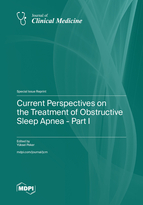Current Perspectives on the Treatment of Obstructive Sleep Apnea - Part I
A special issue of Journal of Clinical Medicine (ISSN 2077-0383). This special issue belongs to the section "Pulmonology".
Deadline for manuscript submissions: closed (15 April 2022) | Viewed by 50168
Special Issue Editor
2. Division of Pulmonary, Allergy, and Critical Care Medicine, University of Pittsburgh School of Medicine, Pittsburgh, PA 15213, USA
3. Department of Molecular and Clinical Medicine, Institute of Medicine, Sahlgrenska Academy, University of Gothenburg, 40530 Gothenburg, Sweden
4. Department of Clinical Sciences, Respiratory Medicine and Allergology, School of Medicine, Lund University, 22185 Lund, Sweden
Interests: obstructive sleep apnea; cardiovascular disease; cerebrovascular disease; phenotypes; biomarkers; drowsy driving; treatment modalities
Special Issues, Collections and Topics in MDPI journals
Special Issue Information
Dear Colleagues,
Obstructive sleep apnea (OSA) is a common disorder with strong associations with cardiovascular, cerebrovascular, metabolic, and cognitive consequences. Continuous Positive Airway Pressure (CPAP) treatment is the first-line therapy for adults with OSA who are symptomatic. However, many individuals with comorbidities do not report symptoms associated with OSA, and adherence to CPAP is poor, especially in individuals with the nonsleepy OSA phenotype.
This Special Issue aims to update the current perspectives on the treatment of OSA in order to highlight multidisciplinary approaches, personalized treatment strategies, and identification of the predictors of response to treatment, both in the general population and in clinical cohorts. We particularly encourage the submission of papers that focus on drowsy driving and cost-benefit aspects of OSA treatment.
Prof. Dr. Yüksel Peker
Guest Editor
Manuscript Submission Information
Manuscripts should be submitted online at www.mdpi.com by registering and logging in to this website. Once you are registered, click here to go to the submission form. Manuscripts can be submitted until the deadline. All submissions that pass pre-check are peer-reviewed. Accepted papers will be published continuously in the journal (as soon as accepted) and will be listed together on the special issue website. Research articles, review articles as well as short communications are invited. For planned papers, a title and short abstract (about 100 words) can be sent to the Editorial Office for announcement on this website.
Submitted manuscripts should not have been published previously, nor be under consideration for publication elsewhere (except conference proceedings papers). All manuscripts are thoroughly refereed through a single-blind peer-review process. A guide for authors and other relevant information for submission of manuscripts is available on the Instructions for Authors page. Journal of Clinical Medicine is an international peer-reviewed open access semimonthly journal published by MDPI.
Please visit the Instructions for Authors page before submitting a manuscript. The Article Processing Charge (APC) for publication in this open access journal is 2600 CHF (Swiss Francs). Submitted papers should be well formatted and use good English. Authors may use MDPI's English editing service prior to publication or during author revisions.
Keywords
- obstructive sleep apnea (OSA)
- continuous positive airway pressure (CPAP)
- weight reduction
- mandibular advancement devices
- upper airway surgery
- hypoglossal nerve stimulation
- cardiovascular morbidity
- phenotypes
- biomarkers
- cost-benefit
- drowsy driving







